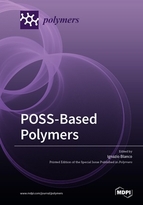POSS-Based Polymers
A special issue of Polymers (ISSN 2073-4360). This special issue belongs to the section "Polymer Chemistry".
Deadline for manuscript submissions: closed (31 January 2019) | Viewed by 89846
Special Issue Editor
Interests: materials; polymers; thermal properties; nanocomposites; composites
Special Issues, Collections and Topics in MDPI journals
Special Issue Information
Dear Colleagues,
The combination of functional polymers with inorganic nanostructured compounds has become a major area of research and technological development owing to the remarkable properties and multifunctionalities deriving from their nano and hybrid structures. In this context, polyhedral oligomeric silsesquioxanes (POSSs) have increasing importance and a dominant position with respect to the reinforcement of polymeric materials. Although POSSs were first described in 1946 by Scott, these materials, however, have not immediately been successful if we consider that, starting from 1946 and up to 1995, we find in the literature 85 manuscripts regarding POSSs; which means that less than two papers per year were published over 50 years. Since 1995, we observe an exponential growth of scientific manuscripts concerning POSSs. It is changing from an annual average of 20 manuscripts for the period 1995–2000 to an annual average of about 400 manuscripts, with an increase of 2800%. The introduction of POSSs inorganic nanostructures into polymers gives rise to polymer nanostructured materials (PNMs) with interesting mechanical and physical properties, thus representing a radical alternative to the traditional filled polymers or polymer compositions. We are interested in articles that explore POSS Chemistry, POSS Materials and POSS/polymer hybrid systems. Potential topics include, but are not limited to:
- Synthesis and characterization of POSS
- POSS in electronics and energy applications
- POSS in space applications
- Biomedical application of POSS nanoparticles
- POSS/polymers nanocomposites
Guest Editor
Keywords
- Polyhedral oligomeric silsesquioxanes (POSS)
- POSS-based composites
- Hybrid systems
- Polymer nanostructured materials
- Nanocomposites
Related Special Issue
- Silicon-Containing Polymeric Materials in Polymers (130 articles)







